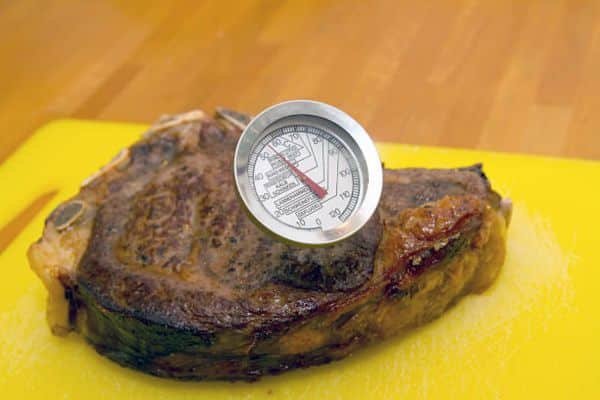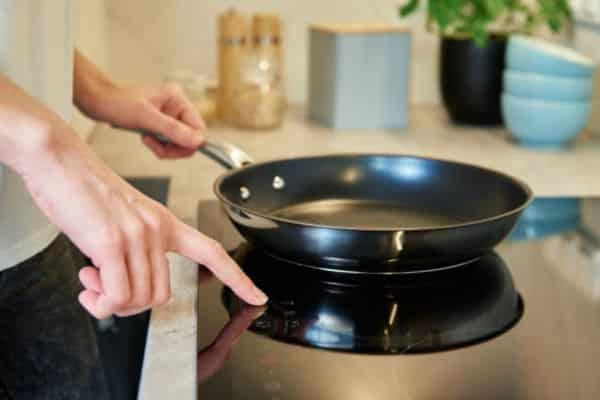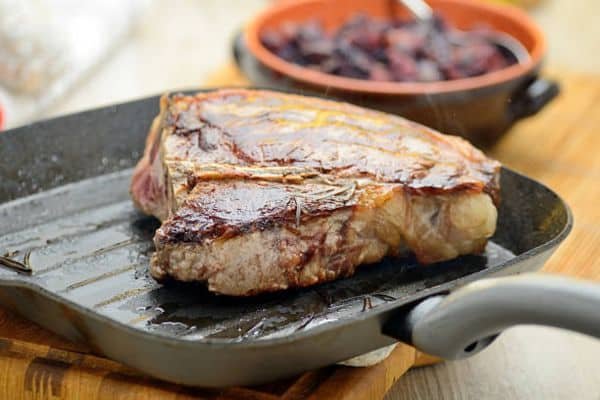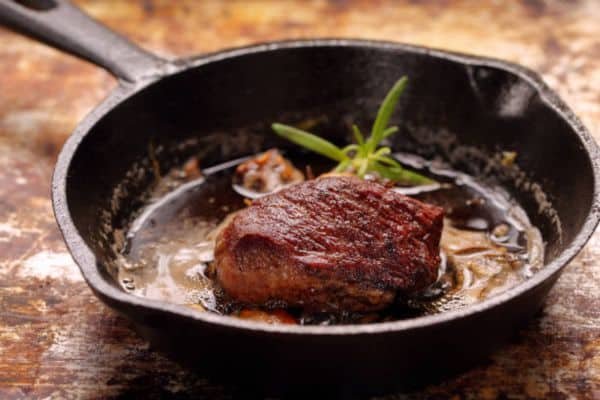I learned how to pan fry a porterhouse steak by accident. One rainy night, my grill gave out. I grabbed a cast-iron pan and gave it a shot. The smell was rich. The crust? Crisp and brown. That moment changed how I cook steak forever. Now I prefer pan-frying over grilling. It’s simple, fast, and full of flavour. No smoke, no stress. You don’t need fancy tools—just salt, heat, and care. In this guide, I’ll walk you through each step. You’ll get a juicy steak and the bold crust you’ve always wanted—right from your kitchen.
What Makes a Porterhouse Special (And Worth Pan-Frying)
The porterhouse is a two-in-one steak. One side is tenderloin—soft and mild. The other is strip steak—bold and juicy. A T-shaped bone holds them together.
That bone adds more than shape. It helps the meat cook slow and evenly. Keeps the steak juicy. It also gives the steak a deep, rich taste as it heats.
This cut works well in a pan. Most porterhouse steaks are thick—about 1.5 to 2 inches. That’s just right for stovetop heat. Thin steaks cook too fast and dry out. Thick ones hold heat better and give you more control.
Tools and Ingredients You’ll Need (Nothing Fancy)
You don’t need a fancy setup to make a great steak. Just a few solid tools and good ingredients will do the trick.
Here’s what I use in my kitchen:
- A cast iron skillet or any heavy fry pan
- A pair of tongs
- A wooden or plastic cutting board
- A few paper towels
Optional, but helpful:
- A meat thermometer
- A splatter screen for cleanup
For the steak, you’ll want:
- One porterhouse steak (about 1.5 to 2 inches thick)
- Kosher salt
- Black pepper
- A neutral oil like canola or avocado
- A few garlic cloves (smashed)
- A couple of sprigs of fresh thyme or rosemary
- Unsalted butter
Let’s talk pans for a second. I love using the best small fry pan for eggs when I’m cooking breakfast. It’s fast, heats up quick, and fits one or two eggs just right. But that same pan won’t cut it for a porterhouse. It’s too light and too small.
Step-by-Step: How to Pan Fry a Porterhouse Steak
01. Let the Steak Reach Room Temp

Take the steak out of the fridge 30 to 45 minutes before cooking. A cold steak cooks unevenly. Letting it sit helps it cook evenly from edge to centre.
02. Pat Dry Thoroughly
Use paper towels to blot all moisture off the surface. Dry meat sears better. Wet meat just steams.
03. Season Both Sides Generously
Sprinkle kosher salt and cracked black pepper on both sides and the edges. Don’t hold back. A thick steak needs bold seasoning.
4. Preheat Pan Until Very Hot

Place your cast-iron or heavy pan on high heat. Let it heat for 5 minutes or until it just starts to smoke. A hot pan builds the crust.
5. Add Oil
Pour in a thin layer of oil. Swirl it to coat the pan. The oil should shimmer right away.
06. Sear First Side (No Flipping Yet)
Place the steak in the pan away from you. Let it sear untouched for 3 to 4 minutes. This creates that rich, golden crust.
7. Flip, Add Butter and Herbs
Use tongs to flip the steak gently. Add 2 tablespoons of butter, smashed garlic, and fresh herbs to the pan. The butter will melt fast—this is where flavor starts building.
08. Baste with Butter
Tilt the pan slightly. Spoon the melted butter over the steak again and again. This adds color, moisture, and flavor to the top.
09. Sear Edges
Use tongs to hold upright. Press the fat edge into for about 30 seconds. This step gives you bonus flavor and helps render the fat.
10. Check Doneness

Use a meat thermometer if you have one. For medium-rare, look for 130°F. No thermometer? Press the center—it should feel soft with slight bounce.
11. Let It Rest
Transfer the steak to a cutting board. Let it rest for 10 minutes. This helps the juices stay inside the meat, not run across the board.
12. Slice and Serve
Slice along the bone to separate the tenderloin and strip sides. Cut each into thick slices. Serve hot, and watch everyone’s eyes light up.
Pro Tips for Better Flavor and Texture

Dry Meat = Better Crust
Always pat dry before cooking. Moisture kills the sear. Dry meat gives you that rich, brown crust every time.
Resting Makes All the Difference
Rest the steak after cooking. This lets the juices settle. Cut too soon, and the flavor runs out onto the board.
Use a Thermometer (At First)
A meat thermometer takes out the guesswork. Once you learn the feel, you won’t need it. But until then, it’s the easiest way to get it right.
Angle the Tenderloin for Even Cooking
The tenderloin side is softer and cooks faster. If has uneven heat, angle the bone so the tenderloin sits toward the cooler side. This keeps both sides from overcooking.
Don’t Overcrowd the Pan
One steak per pan is best. Adding more cools the pan fast. That means steam, not sear—and no one wants grey steak.
Mistakes I’ve Made—So You Don’t Have To

Starting with a Cold Steak
I used to rush things. I’d pull from the fridge and throw it right. The outside cooked fast, but the inside stayed cold and raw. Let it warm up first—it makes a big difference.
Using Too Much Oil
More oil doesn’t mean more flavor. I’ve learned to use just enough to coat. Too much oil can drown the crust and make the taste greasy.
Skipping the Rest Period
I used to slice my steak the second it came off the heat. I was hungry—but also wrong. Resting gives the juices time to settle. Now I wait ten minutes, no matter what.
Trying to Use a Small Pan
One time I grabbed my best small fry pan for eggs. It’s great for sunny-sides and quick meals—but it couldn’t handle the porterhouse. The steak didn’t fit, and couldn’t hold the heat.
Cutting Too Soon
I’ve done this more times than I’d like to admit. You work hard to get that crust, then lose all the juice on the cutting board. Now I treat resting like a rule, not a suggestion.
What to Serve with Your Porterhouse
A steak this good doesn’t need much. Still, a few simple sides can turn it into a full meal.
Pan-Seared Potatoes
Slice small potatoes thin. Sear them in butter and a bit of garlic. Cook until golden and crisp. They’re rich, warm, and perfect next.
Garlic Green Beans
Toss green beans in olive oil and minced garlic. Sauté until they’re bright green and just tender. They add freshness and color to the plate.
Quick Salad
Mix arugula or spinach with lemon juice, olive oil, and shaved parmesan. It’s light, crisp, and balances richness.
Sauce or Compound Butter
Make a quick sauce by deglazing with broth or wine. Add a spoon of mustard or a splash of cream. Or try compound butter—mix soft butter with herbs, garlic, or lemon zest and chill it. Place a slice on top of the hot steak before serving.
Final Thoughts
Cooking a porterhouse in a pan might sound fancy, but it’s not. Once you try it, you’ll want to do it again. The sound of the sizzle, the smell of the butter, the way the crust forms—it’s magic in minutes. You don’t need fancy gear. You don’t need years of training. All you need is a good pan, simple steps, and a bit of patience. The steak does the rest.

